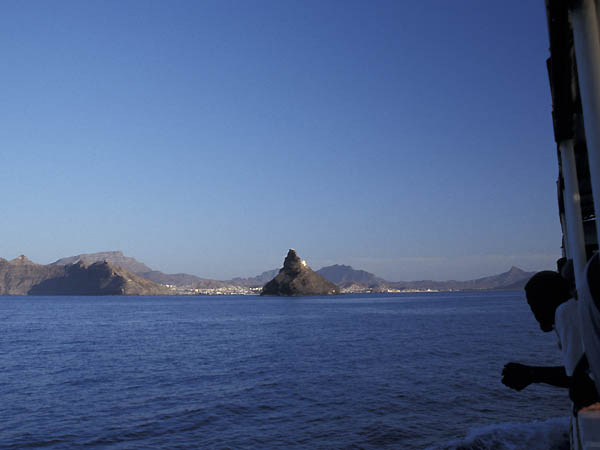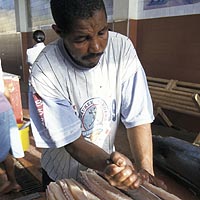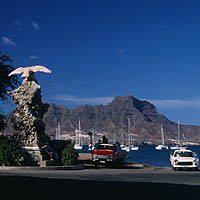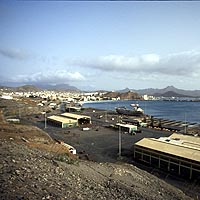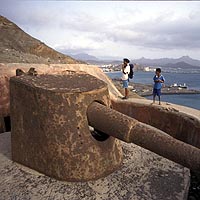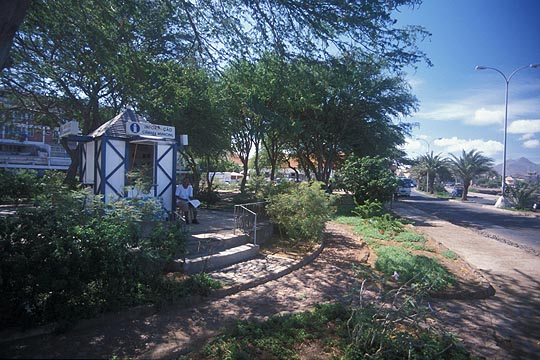|
The Legend tells you what the arrows í mean and how the terms "right" and "left" are used. |
Águia
- Informação Turística |
||||||||
List of Tracks
|
The walk along the shore of the Porto Grande bay may easily last
several hours if somebody tries to look at all details offered along the
track. The aristocrat among streets starts at the Fishmarket, Mercado de Peixe. The Tower at its side is a small replica of the famous tower Torre de Belém in Lisbon, greeting the discovers when leaving for the open Atlantik. Eagle's Monument Águia. It was erected in order to memorize the first flight across the Southern Atlantic in 1922. The pilots Gago Coutinho and Sacadura Cabral made a stop in São Vicente on their difficult way from Lisbon (17 03 1922) to Rio de Janeiro (17 07 1922). Right in front of the Eagle, there is the former customs building Alfândega Velha, strongly built like a mideaval jailhouse, today used as a House of Culture Centro Cultural. Exibitons take place and there is a good bookshop and an internet-café for the public. The Tourist-Information follows a few steps later in the tiny blue and white Kiosk on the Praça Gonçalv Gonês. This is the place where you find the City-Map and map of Sao Vicente you need to use this internet guide. Postcards are sold and you may ask whatever you want to know about Cape Verde. On top of another little park where Rua Angola connects to the Avenida, quite close to Residencial Maravilha, there is a pitoresque old colonial building where young people produce and sell products of arts. This is a worthwhile place to visit for tourist hunting for a souvenir that is not mass-produced. The Ferry Harbour got a new building that looks like a ship itself. There is a twin - building on the other side of the channel in Porto Novo town. At the entry to the Harbour there is a row of small wooden baracks. Those are the offices of the Despachantes, agencies to help clearing goods at customs. Customs regulations are quite complicated and they have enough work. Like in many micro-societies on islands, an effective way of taxing the population is having them pay on imported goods. Moave, is the only industrial mill in the city. About 90% of consumption has to be covered by importation. For the owners of donkeys and mules, chaff is as important as corn and wheat. Without enough fibres, those animals can not work hard. The huge Container Harbour behind the Moava building was built in the 1990s. On top of everything, overlooking harbour, city and the channel, there
is the "little fortress" Fortim.
It is older than the town and when it was built, its purpose was to deter
the pirats from hiding in the harbour to prepare for attacks on ships,
towns and villages. Later Fortim became the city jail. Laginha is the inner-city
beach of Mindelo and it is busy all day. In the early morning Joggers and Body
Builder are coming to work out, somewhat later young mothers with their
babies, thereafter pupil and adolescents and in the late evening, the
upper-middle class comes to the restaurants for a beer and a fried
chicken. Despite its proximity to the shipyard, the water of Laginha is of
good quality due to currents. The hangars across the street are no more used for storing food-aid. In modern time, delivery is "just in time". So they are used for fairs to promote Cape Verde as a producer and consumer of industrial goods. The little Garden Restaurants, Gabylandia and others are a nice place to pass away the time. Heavy Diesel engines are heard all over the area. They belong to the Seawater Desalination Plant of ELECTRA. Over in the last decades it has improved its reliability considerably. Blackouts became rare and the times when there was no sweet water for weeks are over. But desalination pushes living cost up. Every droplet of sweet water, every KWh is produced with imported fuel. The hope to substitute it by renewable energies continues to be just a hope, as long as the available technology does not resist the combination of Sahara dust and seawater in the air, heat and extremely strong winds over several months. Please sharpen your sense for orientation after having passed by the entry of ELECTRA and reaching the crossing, because here follows the only opportunity to loose the track. You should neither walk up the main street to Chã de Alecrim nor continue on the main street following the wall around the industrial complex. There is a smaller street climbing the hill é exactly northward. On top, it turns left and you reach the hight between ELECTRA and the shipyard CABNAVE. Then there follows a spider of little streets leading to private houses. None of them is correct. The only right one is the one acompanying the slope é northward. The huge square bilding with the overhanging roof, once was the residence of the British Ambassador. Since independence it belongs to a successful co-operative of artists, Atelier Mar. The multi- talent and founder, Leão Lopes - painter, potter, writer, playwriter, film-producer, inventor of alternative building styles and material, journalist, ex-minister of culture - whoever knows which profession he has not experienced? You may visit the Atelier and buy some products - not so cheap but excellent! When passing the following slope, you look down on CABNAVE, a shipyard built in the 1980s. It does mainly repair of the local fleet. Dreams of production for international markets, making use of the "cheap labour force of Cape Verde" have ended after evaluating living cost and production cost in Cape Verde. Every droplet of drinking water, every KWh .......... are the end of most dreams of industrial production in this country. Now the pathway climbs slowly and the view over Porto Grande, with the rocks of Morro Branco on the western extreme is widening. The latter continues to be a military area. The former portuguese army barracs we have to pass on this side are abandoned. In
the middle of the bay, Ilheu dos
Pássaros defends its place agains all cavetousness
coming to cape verdean shores. In the 15th century it has seen portuguese
soldiers and "discoverors" and catalane sailors coming to
harvest urzela, a staining lichen. Later pirats came to
hide away in the ideal natural harbour. In the 19th, when Mindelo grew as
a town within a few decades, Ilheu has seen hundreds and hundreds of steam
ships simultaneously in the bay, unloading and bunkering coal from England and
water from Santo Antao. When the black smoke over the bay has cleared and fuel oil substituted
coal, transatlantic cable from Latin America, North America, Europe and
Africa were pulled into the town by english Telegraph companies, helping Mindelo
to escape the worst of crisis. The canons at Ponta João Ribeiro were hardly ever used. Since the end of the Napoleon wars, Portugals economy was deeply dependent from the UK. This meant there was a strong power watching over Cape Verde from the background and never allowing any competitor to take it away from Portugal because of its unparalleled geo-strategic position in the centre of transport for trade and warfare between Europa and most colonies. Later, during World War II, despite all sympathy of the portuguese fashist government for Hitler and Mussolini, vulnerable little Portugal preferred to remain neutral - and managed not to be occupied by any of the parties. When, after 1945, the very heart of geostratigic interest in the times
of cold war
moved to the Arctic, Cape Verde and the Central Atlantic did not disappear from the screens of the
armies totally, but it was of very reduced interest. In the aera of remote sensing and continent wide aliances, the canons of Ponta de João Ribeiro
are allowed to rust silently.
|
||||||||
|
|
